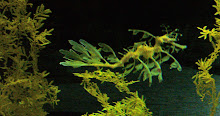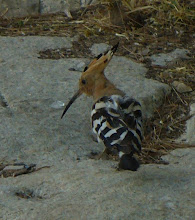Although this may sound like one of the less popular Andrew Lloyd Webber Musicals, today's link is actually about the exceptionally loud mating "call" of a pond insect. The insect- The Lesser boatman,Micronecta scholtzi, attracts females using a sound it generates by rubbing ("stridulating") its penis against its abdomen, or, as the tabloid newspaper, The Sun, puts it "Bug's musical willy breaks noise record"-
http://www.thesun.co.uk/sol/homepage/news/3669816/Bugs-musical-willy-breaks-noise-record.html
The original scientific article is by Paris-based researcher Jérôme Sueur and David Mackie and James F. C. Windmill of the University of Strathclyde and goes by the more sober title of
"So Small, So Loud: Extremely High Sound Pressure Level from a Pygmy Aquatic Insect (Corixidae, Micronectinae)"- you can find it in full online here-
http://www.plosone.org/article/info%3Adoi%2F10.1371%2Fjournal.pone.0021089
Stridulation- "the act of producing sound by rubbing together certain body parts" is best known in grasshopppers and crickets. However, it has been found in a variety of insect species, including weevils and scarab and tiger beetles, as well as in certain tarantulas and even snakes, for example, saw scale vipers (Echis species)
Thursday, 30 June 2011
Friday, 17 June 2011
Porcupines, Fennec Foxes, Prairie Dogs and Red Squirrels
Welcome (back) to Weirdbeautiful: just 4 cute-animal pictures, today; this blog has been low on cuteness lately, so I want to redress the balance.
First of the four is a Mexican Hairy Dwarf Porcupine, Sphiggurus mexicanus, which is found in Costa Rica, El Salvador, Guatemala, Honduras, Mexico, Panama, and, possibly, also Belize and Nicaragua-

picture by Patrick Gijsbers (for image source and (creative commons) license details, click [here]).
You can find more details on porcupines here- http://en.wikipedia.org/wiki/Porcupine
Second image-of-the day is a Fennec Fox, which you can find online -here-->
http://www.zooborns.com/zooborns/2010/10/fennec-friday-.html
Third image of the day is of a two-week old red squirrel (Sciurus vulgaris) baby. Sadly, this species is very rare in Britain these days, thanks to the arrival of the larger and more aggressive grey squirrel from the Americas.

Image by JJM (no copyright- for details, click [here])
Finally, sticking with the furry-mammal theme, today's final image is of Gunnison's Prairie Dog, Cynomys gunnisoni, which, like other prairie dogs and, for that matter, marmots, chipmunks and groundhogs are part of the squirrel family (Sciuridae).

This image also has no copyright (for details, click [here])
First of the four is a Mexican Hairy Dwarf Porcupine, Sphiggurus mexicanus, which is found in Costa Rica, El Salvador, Guatemala, Honduras, Mexico, Panama, and, possibly, also Belize and Nicaragua-

picture by Patrick Gijsbers (for image source and (creative commons) license details, click [here]).
You can find more details on porcupines here- http://en.wikipedia.org/wiki/Porcupine
Second image-of-the day is a Fennec Fox, which you can find online -here-->
http://www.zooborns.com/zooborns/2010/10/fennec-friday-.html
Third image of the day is of a two-week old red squirrel (Sciurus vulgaris) baby. Sadly, this species is very rare in Britain these days, thanks to the arrival of the larger and more aggressive grey squirrel from the Americas.

Image by JJM (no copyright- for details, click [here])
Finally, sticking with the furry-mammal theme, today's final image is of Gunnison's Prairie Dog, Cynomys gunnisoni, which, like other prairie dogs and, for that matter, marmots, chipmunks and groundhogs are part of the squirrel family (Sciuridae).

This image also has no copyright (for details, click [here])
Labels:
Fennec Foxes,
Porcupine,
prairie dogs,
red squirrel
Chilean Volcanic eruption,The Corpse Flower and Quote of the week- Frank Lloyd Wright on trees,

The Corpse flower, Amorphophallus titanum, copyright-free image (for source and details, click [here])
Welcome (back) to Weirdbeautiful
For the past few weeks, I have been buried in mountains of floral photographs, as I sort, arrange and edit the images for two new books. The first book is “Spring Flowers and Summer Rain” and has a lot of arty botanical photography in it with a selection of vaguely philosophical quotes by various great, good (or just-famous) people. The second- “Natural Wonder” is also a photo-rich, coffee-table style book, but has more of a popular science angle to it and features a lot of animal pictures, too. There will be more details of both books on here when the publication contracts have been sorted out, but that may be a while yet. One of the harder parts of both books has been getting the captions correct. As a zoologist, I tend to forget just how fluid “species” are in the plant kingdom and how many of the common plants around us are obscure hybrids and morphs of various better known (but often visually very different- at a first glance, at least) species.
So, given this week’s botanical focus, it seems appropriate for quote-of-the week, on Weirdbeautiful to be about plants -
"The best friend on Earth of Man is the tree. When we use the tree respectfully and economically, we have one of the greatest resources on the Earth"
- Frank LLoyd Wright, American Architect, 1867- 1959.
The first of this week's links is to a stunning picture roaring lions (courtesy of stumbleupon.com)-
http://tinyurl.com/444q9fw
This week's second link is to a news item (video) about the Corpse flower (Amorphophallus titanum)- one of a few famously foul smelling blooms in the world. This particular flower (in the video) is in the Botany Department of the University of Washington in Seatle. The flower, which is native to Sumatra, Indonesia, supposedly smells of rotting flesh- a scent that is attractive to the flies which pollinate it in the wild. The video is online here- -
http://www.msnbc.msn.com/id/21134540/vp/43341732#43341732
and you can find out more about Amorphophallus titanum,[here]

Image= "Puyehue Lake and Volcano seen from the main East-West road (road 215), 8 km east of Entre Lagos township" by Clem23 (for picture creative commons license details, click [here])
Finally, one story that has been much in the news is the Eruption on the 4th June of the Puyehue-Cordón Caulle volcano complex (pictured above, before the latest eruption) in Puyehue National Park, Chile. Some of the most striking images of the eruption are online here-
http://www.emol.com/especiales/2011/fotoshd/erupcion-volcan/
The British tabloid newspaper The Daily Mail ran the same story under the characteristically hysterical title "Hell on Earth: Monster Volcano can be seen from SPACE as it spits fire into the sky", however their article does have some really stunning images of the eruption, taken by the orbiting Aqua satellite -
http://www.dailymail.co.uk/news/article-2000166/Chile-volcano-seen-SPACE-spits-sky.html
You can find more details about the Puyehue-Cordón Caulle Volcanic Complex (PCCVC) [here]and about the June 4th 2011 eruption, [here].
(Many thanks to Iva Lee for the tip off about the Corpse flower news video and to Patricia P. for the link to the emol.com volcanic eruption pictures).
Sunday, 5 June 2011
E. coli, Polar Bears, Sanderlings and Kenya- Science News round-up.

Female Polar Bear (photographed beside Whale Carcass at the Arctic National Wildlife Refuge, Alaska, USA by Alan D. Wilson) (for image source and (creative commons) license details, click [HERE] )
Recent science news has been dominated by the E. coli outbreak in Germany and its casualties in various parts of Europe. The latest news on this, according to both Sky news and The International Herald Tribune, is that the source of the outbreak was or was associated with sprouted beans from a German organic farm-
http://www.nytimes.com/aponline/2011/06/05/world/europe/AP-EU-Contaminated-Vegetables-Europe.html?_r=1&ref=global-home
Organic farming is widely considered more healthy than standard farming by the general public, however, it does have its own problems; so the idea that organic farming could be associated with bacterial problems is not as surprising as the Agriculture Minister seems to imply in this article. Known potential problems with organic food include a higher risk of toxic and carcinogen-producing- moulds growing on the produce than with conventionally farmed vegetables.
One of the more beautiful stories this week is the creation of an ice bear sculpture in Sydney to highlight climate change-
http://tinyurl.com/5wzlgqo
Sticking with the Polar bear theme , the first Quote-of-the-week this week is taken from the Kenya Diary the British Army Intelligence Officer, voracious Game Hunter, Ornithologist and Diarist Richard Meinertzhagen-
“I sat by the lake most of the day, watching the hippo, duck and flamingo. There are still a few northern waders about, notably greenshank, marsh sandpiper and little stint. One single sanderling attracted my attention for being so far inland. To consort with hippo in winter and polar bears in summer must be a delightful experience and yet that is what this small bird must do every year.”
-Richard Meinertzhagen, 21st Feb 1903, Lake Nakuru, Kenya.(Kenya Diary, 1902-06 (1902-1906)

Sanderling, picture by Pierre Camateros, (for image source and (creative commons) license, click [HERE] )
The Sanderling, which has been described, variously, by three biological names- Calidris alba, Crocethia alba and Erolia alba – is a small wading bird with a famously long migratory route. It is unusual because it has also been known to form polyandrous (one female and two male) pairings in the mating season, with one female pairing off with two males, instead of the more usual monogamous pairs of one male and one female.
(You can find more details about it [HERE]).
Meinertzhagen’s diaries are famously blood-soaked accounts
The second, and final quote-of-the-week, then is his comments on viewing a lunar rainbow -
“I went to the top of Silie Hill after supper. It was full moon at the time with a fairly heavy mist. I witnessed for the first time a lunar rainbow, which was very beautiful, though somewhat weird”
- Richard Meinertzhagen, 12th November 1905. Silie Hill, Nandi, Kenya, Kenya Diary, 1902-06 (1902-1906)

Image of lunar rainbow (moonbow) over Victoria Falls (image by Calvin Bradshaw – for image source and license details, click [HERE]).
Subscribe to:
Comments (Atom)








